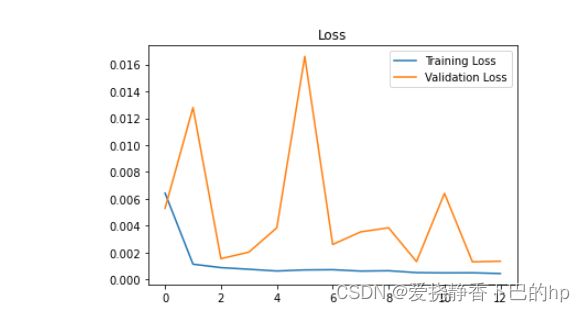LSTM预测黄金价格
LSTM预测黄金价格
数据代码下载地址见文末
数据说明
Date-日期
Close/Last-收盘价
Volume-成交量
Open-开盘价
High-最高价
Low-最低价
导入数据
import os,math
from tensorflow.keras.layers import Dropout, Dense, Dense, LSTM,LayerNormalization
from sklearn.preprocessing import StandardScaler,MinMaxScaler
from sklearn import metrics
import numpy as np
import tensorflow as tf
from matplotlib import pyplot as plt
import pandas as pd
%matplotlib inline
from tensorflow.keras.models import Sequential
plt.rcParams['font.sans-serif'] = ['SimHei']
plt.rcParams['axes.unicode_minus'] = False
df = pd.read_csv('/home/mw/input/data2152/gold_data.csv')
df.head()
Date Close/Last Volume Open High Low
0 10/28/2022 1648.3 186519.0 1667.2 1670.9 1640.7
1 10/27/2022 1668.8 180599.0 1668.8 1674.8 1658.5
2 10/26/2022 1669.2 183453.0 1657.7 1679.4 1653.8
3 10/25/2022 1658.0 178706.0 1654.5 1666.8 1641.2
4 10/24/2022 1654.1 167448.0 1662.9 1675.5 1648.0
df.isnull().sum()
Date 0
Close/Last 0
Volume 39
Open 0
High 0
Low 0
dtype: int64
看下趋势
#设置画布
fig,ax = plt.subplots(figsize=(9,6), dpi=100)
#设置子图间距
Date = df['Date']
stock_Close = df['Close/Last']
ax.plot(Date, stock_Close, '-', color='lightskyblue', alpha=0.8, label='close')
ax.legend(loc="best")
ax.set_xlabel('Date')
fig.autofmt_xdate()
切分数据
train, test = df.loc[df['Date'] <= '2021-01-01'], df.loc[df['Date'] > '2021-01-01']
train.shape, test.shape
((2087, 6), (460, 6))
数据标准化
scaler = MinMaxScaler(feature_range=(0, 1))
train['Close/Last'] = scaler.fit_transform(train[['Close/Last']])
test['Close/Last'] = scaler.transform(test[['Close/Last']])
构造数据
TIME_STEPS=365
def create_sequences(X, y, time_steps=TIME_STEPS):
Xs, ys = [], []
for i in range(len(X)-time_steps):
Xs.append(X.iloc[i:(i+time_steps)].values)
ys.append(y.iloc[i+time_steps])
return np.array(Xs), np.array(ys)
X_train, y_train = create_sequences(train[['Close/Last']], train['Close/Last'])
X_test, y_test = create_sequences(test[['Close/Last']], test['Close/Last'])
print(f'Training shape: {X_train.shape}')
print(f'Testing shape: {X_test.shape}')
Training shape: (1722, 365, 1)
Testing shape: (95, 365, 1)
构建模型
model = Sequential()
model.add(LSTM(50, return_sequences=True, input_shape=(X_train.shape[1], X_train.shape[2])))
model.add(Dropout(rate=0.2))
model.add(LSTM(40, return_sequences=True))
model.add(Dropout(rate=0.2))
model.add(LSTM(30))
model.add(Dropout(rate=0.2))
model.add(Dense(1))
model.summary()
Model: "sequential_14"
_________________________________________________________________
Layer (type) Output Shape Param #
=================================================================
lstm_42 (LSTM) (None, 365, 50) 10400
_________________________________________________________________
dropout_42 (Dropout) (None, 365, 50) 0
_________________________________________________________________
lstm_43 (LSTM) (None, 365, 40) 14560
_________________________________________________________________
dropout_43 (Dropout) (None, 365, 40) 0
_________________________________________________________________
lstm_44 (LSTM) (None, 30) 8520
_________________________________________________________________
dropout_44 (Dropout) (None, 30) 0
_________________________________________________________________
dense_14 (Dense) (None, 1) 31
=================================================================
Total params: 33,511
Trainable params: 33,511
Non-trainable params: 0
_________________________________________________________________
模型编译
lr = 1e-2
optimizer = tf.keras.optimizers.Adam(learning_rate=lr)
model.compile(loss='mean_squared_error',
optimizer=optimizer)
from tensorflow.keras.callbacks import ModelCheckpoint, EarlyStopping
epochs = 80
# 保存最佳模型参数
checkpointer = ModelCheckpoint('best_model.h5',
monitor='val_loss',
verbose=1,
save_best_only=True,
save_weights_only=True)
# 设置早停
earlystopper = EarlyStopping(monitor='val_loss',
min_delta=0.001,
patience=10,
verbose=1)
训练开始
history = model.fit(X_train, y_train,
batch_size=64,
epochs=epochs,
validation_split=0.2,
validation_freq=1,
callbacks=[checkpointer, earlystopper])
Epoch 1/80
22/22 [==============================] - 41s 2s/step - loss: 0.0064 - val_loss: 0.0053
Epoch 00001: val_loss improved from inf to 0.00529, saving model to best_model.h5
Epoch 2/80
22/22 [==============================] - 35s 2s/step - loss: 0.0011 - val_loss: 0.0128
Epoch 00002: val_loss did not improve from 0.00529
Epoch 3/80
22/22 [==============================] - 35s 2s/step - loss: 8.6890e-04 - val_loss: 0.0015
Epoch 00003: val_loss improved from 0.00529 to 0.00153, saving model to best_model.h5
Epoch 4/80
22/22 [==============================] - 35s 2s/step - loss: 7.4595e-04 - val_loss: 0.0020
Epoch 00004: val_loss did not improve from 0.00153
Epoch 5/80
22/22 [==============================] - 35s 2s/step - loss: 6.1666e-04 - val_loss: 0.0038
Epoch 00005: val_loss did not improve from 0.00153
Epoch 6/80
22/22 [==============================] - 35s 2s/step - loss: 6.9752e-04 - val_loss: 0.0166
Epoch 00006: val_loss did not improve from 0.00153
Epoch 7/80
22/22 [==============================] - 35s 2s/step - loss: 7.1338e-04 - val_loss: 0.0026
Epoch 00007: val_loss did not improve from 0.00153
Epoch 8/80
22/22 [==============================] - 35s 2s/step - loss: 6.1054e-04 - val_loss: 0.0035
Epoch 00008: val_loss did not improve from 0.00153
Epoch 9/80
22/22 [==============================] - 35s 2s/step - loss: 6.3556e-04 - val_loss: 0.0038
Epoch 00009: val_loss did not improve from 0.00153
Epoch 10/80
22/22 [==============================] - 35s 2s/step - loss: 4.9548e-04 - val_loss: 0.0013
Epoch 00010: val_loss improved from 0.00153 to 0.00131, saving model to best_model.h5
Epoch 11/80
22/22 [==============================] - 35s 2s/step - loss: 4.7562e-04 - val_loss: 0.0064
Epoch 00011: val_loss did not improve from 0.00131
Epoch 12/80
22/22 [==============================] - 35s 2s/step - loss: 4.8332e-04 - val_loss: 0.0013
Epoch 00012: val_loss improved from 0.00131 to 0.00130, saving model to best_model.h5
Epoch 13/80
22/22 [==============================] - 35s 2s/step - loss: 4.2576e-04 - val_loss: 0.0013
Epoch 00013: val_loss did not improve from 0.00130
Epoch 00013: early stopping
训练过程中损失可视化
plt.plot(history.history['loss'], label='Training Loss')
plt.plot(history.history['val_loss'], label='Validation Loss')
plt.title('Loss')
plt.legend()
模型预测
model.load_weights('/home/mw/project/best_model.h5')
pre = model.predict(X_test, verbose =1)
predicted_price = scaler.inverse_transform(pre)
real_price = scaler.inverse_transform(test[['Close/Last']][365:])
3/3 [==============================] - 1s 169ms/step
plt.plot(real_price, color='red', label='Gold Price')
plt.plot(predicted_price, color='blue', label='Predicted Stock Price')
plt.title('Gold Price')
plt.xlabel('Time')
plt.ylabel('Price')
plt.legend()
R2 = metrics.r2_score(predicted_price, real_price)
print('R2: %.5f' % R2)
R2: 0.81060
数据代码下载
往期文章可以关注我的csdn
或者和鲸社区专栏专栏下巴同学的数据加油小站
会不定期分享数据挖掘、机器学习、风控模型、深度学习、NLP等方向的学习项目
代码地址:跳转后,点击右上角fork可以获得
数据地址:上述代码地址有数据,CSDN我也传了一份CSDN数据下载


